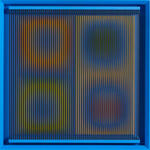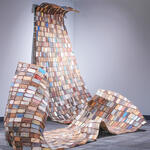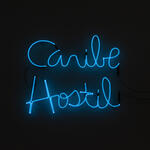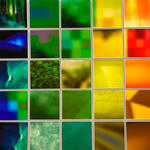
Ainelén Bertotti Burket
Bio
AINELÉN BERTOTTI BURKET
Born in Venado Tuerto in 1994, Ainelen is a carpenter and visual artist.
In 2013, she began studying Bellas Artes at Universidad Nacional de Rosario. In 2020, she was selected by UNIBO to participate in an exchange program at the University of Bologna, Italy.
In 2017, she was named Distinguished Artist of the City of Rosario by the Honorable City Council of Rosario.
Her notable training and production residencies include:
Nuevas Preguntas (Art clinic led by Eugenia Calvo and Cecilia Lenardon, Escuela Municipal de Artes Plásticas Manuel Musto, Rosario, Argentina, 2023)
URRA Cerrito (Buenos Aires, Argentina, 2022)
Escuela Prestada (Escuela Municipal de Artes Plásticas Manuel Musto, Rosario, Argentina, 2022)
Artwork clinic with Mauro Guzmán (Rosario, Argentina, 2019/2020)
Taller Compartido (Galería Crudo, Rosario, Argentina, 2018)
She has participated in numerous group exhibitions, including:
Premio 8M (CCK, Buenos Aires, Argentina, 2023)
Cúmulo (Galería Del Infinito, Buenos Aires, Argentina, 2022)
Bienal de Arte Joven (CCR, Buenos Aires, Argentina, 2022)
Visual Arts Prize, FNA (CCK, Buenos Aires, Argentina, 2020)
Bienal UNL (Santa Fe, Argentina, 2018)
Firenze Biennale (Florence, Italy, 2017 and 2019)
Her solo exhibitions include:
“Lo que lleva tiempo” (Cabina, Galería Subsuelo, Rosario, Argentina, 2023)
“La energía de las cosas” (Galería Subsuelo, Rosario, Argentina, 2019)
“Inefable” (Casa de Buenos Aires, Rosario, Argentina, 2014)
She has received several awards, such as:
Performing Arts Prize, Amigos del Bellas Artes + ArtHouse (2022)
Young Art Biennial Prize (2022)
Fourth Prize at the Florence Biennale (2017)
Additionally, she was granted:
A residency scholarship at Curadora, San José del Rincón, Santa Fe, Argentina (September 2023)
An individual creation grant from FNA (2021)
In 2022, Ainelen launched a clothing and jewelry collection exploring the aesthetics of workshop spaces, their connection to tools, and the diverse corporealities found within them.
Since 2019, she has been teaching carpentry workshops for women and gender-diverse individuals.
Ainelen lives and works in Rosario, Santa Fe, Argentina.
Statement
My pieces originate from dreamlike images and the observation of tasks I perform in daily life. Trades related to construction (masonry, carpentry, blacksmithing, etc.) represent an empirical knowledge that runs through my family heritage and shapes my artistic practice. I view these acquired skills as practices that repeat yet are never identical, finding their uniqueness in that variation.
I work from an idea I imagine freely, without initially considering its technical resolution. I don’t create sketches; instead, I trust in what I envision, allowing space for a process that is permeable, accidental, and simultaneously one of transformation and destruction—elements inherent and faithful to my personal exploration.
My work embodies a relationship between my body, the embodied craft, the materials used, and the passage of time. The mark of the human hand is, in the end, the connection between the body and the materials, a trace left imprinted on the work.
I am particularly interested in working with noble materials like wood, stone, and metal—elements fundamental to construction throughout history. These materials are silent witnesses and participants, embodying millions of years of stillness and history. They carry the passage of time and its energy, often regarded as inert resources by humanity.
I carry out processes where the matter transforms into something else through the use of tools, while still retaining its temporal potency and natural origin. The pieces are defined by their materials, as if engaging in alchemical processes that amplify their voices, scents, and textures, emphasizing the inherent qualities of the materials used.
When working with objects, I am drawn to the formal synthesis that arises from the relationship between the piece and its surrounding space. I think of them as installations that are part of a space and a time that define, modify, and magnetize them. A time that precedes, permeates, and remains in the artwork. I am intrigued by the power of synthesis in my works—the objectual result of an intimate and immersive process of observation and labor. A static object that invites movement or potential actions hidden behind my works.
I aim for any viewer to confront the piece through its material honesty, entering an open field of meanings—a nonverbal dialogue with the work as an open possibility to engage with it as they wish.
In my practice, art is defined as a sincere approach to a question, not a certainty or a singular truth. This open question is answered by the materialities being explored and the final work. There are multiple possibilities and directions, and the piece is merely an approximation to all those imagined possibilities, to other potential worlds.
I think of art as the naive ability to observe and imagine something that does not yet exist and the possibility of creating something without knowing where it will lead. Art as a strategy of play, which can later be named as art.
Additional information
Esta obra pretende generar una imagen que nos conecte como ciudadanos y nos sitúe como espectadores de la poesía cotidiana.
Se propone el juego de encontrar formas humanas dentro de las herramientas.
Estas máquinas podrían generar una asociación directa al deseo de tener extremidades lo suficientemente poderosas para extendernos y rozar las texturas visuales del horizonte.
Existe un imaginario sobre la rebelión de las máquinas ligado a la ciencia ficción con una impronta violenta y destructiva. Paradójicamente, es el mismo sistema capitalista el que plantea ese futuro distópico. Esta obra ensaya un armagedón alternativo. Y se pregunta: ¿qué pasaría si las máquinas imitaran otros comportamientos humanos? como besarse, abrazarse, dibujar o bailar.
Aquí se intenta exponer máquinas y operarios siendo improductivos según los parámetros industriales y sociales imperantes.
Rascacielos es una performance que tiene como protagonistas a un trío de brazos articulados y sus respectivos operarios realizando una coreografía al ritmo del vals Voces de Primavera, de Johann Strauss.
La música es interpretada por una orquesta en vivo (puede ser formato reducido de cuerdas).
Esta es una obra interdisciplinar en la que la autora convocó a una coreógrafa, 3 operarios devenidos en performers y 3 máquinas, para componer un lenguaje en común y a partir de ello diseñar y ensayar una coreografía que tiene una duración en total aproximada de 10 minutos.
Este proyecto ha sido ganador del subsidio anual Plan Fomento 2022/23 de Industrias Creativas del Ministerio de Innovación y Cultura de la Provincia de Santa Fe, Argentina. Rascacielos obtuvo el Premio Artes Performáticas de Arthaus y Amigos del Bellas Artes por lo que contó con la mentoria de Silvia Gurfein y Mariana Obersztern.

















